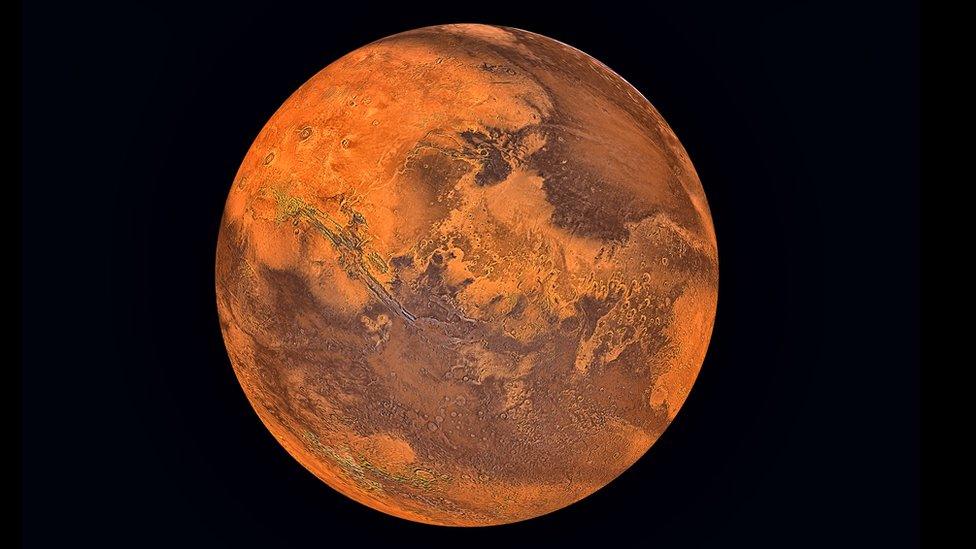Mars close approach: Get a look at the red planet
- Published
- comments

It's an exciting few days for space watchers as Mars will be coming the closest it's been to Earth for 15 years.
The phenomenon is called a Mars close approach, which is when the red planet and Earth come nearest to each other in their orbits around the Sun.
Mars will still be 35.8 million miles away though, so there's certainly no danger of it bumping into us.
When a close approach happens, a rumour often flies around that Mars will look as big as the Moon in the night sky, but this isn't true!
To start with, on 27 July, something called a Mars opposition will happen, when Mars, the Earth and the Sun all directly line up. This is when Mars should start to come into view from Earth.
Then, on 31 July, the Mars close approach will happen, so this will be your best chance to take a look! Although the planet will still be visible for a while after this, before its orbit takes it further away again.
Nasa has said that there is currently a dust storm which is affecting the whole planet, so this may make seeing details on Mars a little more difficult for astronomers.
Of course, you will get the best look at the close approach through a telescope, but if you don't have one and you want to see the planet closer up, then it could be worth contacting your local planetarium or astronomy centre to see if they're holding any special events for it.
A dust storm on Mars at the moment might make it tricky for astronomers to see much detail on the planet on this occasion
A Mars close approach happens about once every 26 months (just over two years). This is why you will often see Mars missions launching every two years. You can find out everything about the latest mission, which blasted off in May 2018, here.
The reason that the distance between Earth and Mars changes like this is because they have elliptical (egg-shaped) orbits.
The gravitational pull by other planets also constantly changes the shape of their orbits a little bit, with Jupiter especially influencing the path that Mars takes around the Sun.
The latest exciting mission saw the Nasa InSight lander blast off towards the red planet in May - two months ahead of Mars coming close to Earth
In 2003, the red planet came 34.8 million miles close to Earth, which was the closest it's been to us in 59,619 years. It won't come that close again until the year 2287!
The next Mars close approach is on 6 October 2020 when the planet will be 38.6 million miles away.
July is a very exciting time for space fans, with the longest total lunar eclipse of the century happening at the end of the month too.
Facts about Mars
Mars is known as the red planet because it has lots of iron oxide on its surface giving it that rusty red colour
It is the second smallest planet in the system and fourth in line from the Sun meaning it can get pretty cold there
Same as the Earth, it has a North and a South pole which are covered in ice, and reaching temperatures as low as -140C
20C is the highest temperature on Mars, similar to a sunny day back here on Earth
A day on Mars is slightly longer than here at 25 hours, but a Mars year is almost twice as long as an Earth year, as the planet takes 687 days to orbit the sun
Mars has the highest mountain in the solar system, called Olympus Mons, which measures around 15 miles high - that's three times taller than Mount Everest!
- Published3 April 2018
- Published12 February 2018
- Published28 March 2014
